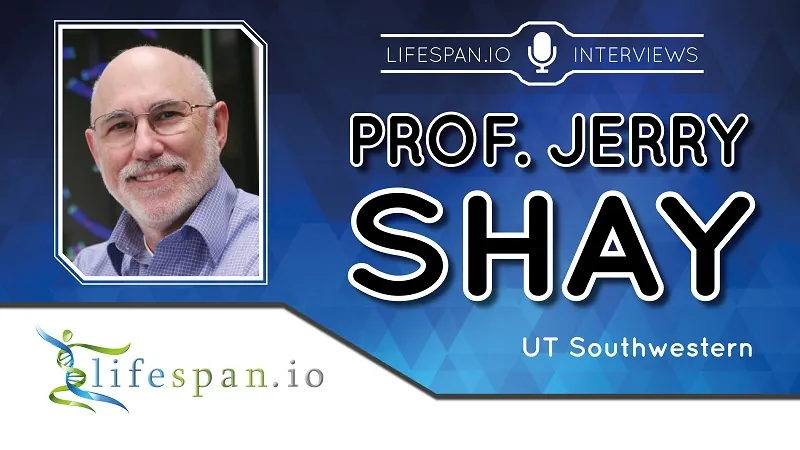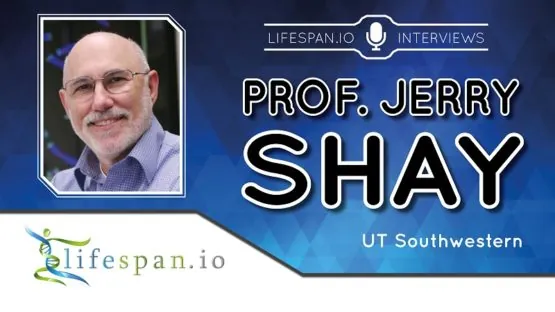Professor Jerry Shay of the Shay/Wright lab is perhaps most well-known for his research on telomeres and telomerase and their relation to cancer and aging.
He has been instrumental in the development of telomerase inhibitors, which turn off the expression of telomerase in cancer cells; this expression is one way in which cancer cells become immortal and divide constantly. His team is also developing another treatment, a small molecule that can uncap the telomeres of cancer cells.
Telomeres are a proposed primary hallmark of aging, but their role in aging is often misunderstood as simply being a replicative clock. However, it seems that their role in regulating gene expression and their contribution to genomic and epigenomic stability is more important.
We had the opportunity to interview Professor Shay at the recent Undoing Aging conference in Berlin.
Can you explain how telomeres regulate gene expression via TPE and TPE-OLD?
TPE is a term that has been around for decades. It stands for telomere position effect. This concept is that the chromatin near telomeres is different from the rest of the genome and generally involves silencing of genes. In yeast, if one moves an actively expressed gene near a telomere, then it becomes silenced. We reasoned that in humans, telomere length changes could also change gene expression so that when telomeres are long (early in human life), certain genes are repressed, and with increased age and progressive telomere shortening, then certain genes (perhaps near telomeres) could become active. We call this TPE-OLD (over long distances) or telomere looping.
We have shown that the gene regulating the protein (catalytic) component of telomerase is very close to a telomere in humans and all large long-lived mammals. Using a variety of cell and molecular techniques, we published in PloS Biology a few years ago that the TERT (telomerase) gene was regulated by TPE-OLD [1].
This has great explanatory values for an aging concept called antagonistic pleiotropy. This means that things that could be beneficial early in life may have unexpected harmful consequences late in life. Thus, we need telomerase during early development when there is rapid tissue growth, and when telomeres reach human typical size, the telomere loops over and silences the TERT genes. As we age and telomeres shorten, then the telomere can no longer influence the repression of telomerase, and thus telomerase may become reactivated in mostly older individuals as part of cancer progression.
What do you think is the best method of measuring telomeres?
We call the most sensitive assay TeSLA, for telomere shortest length assay. Most scientists use a Q-PCR assay that is not very reliable but easy to use. It is well established that it is the shortest telomeres that leads to replicative senescence. There are thousands of published papers using the Q-PCR making extraordinary claims based on very small differences in average telomere length. Other methods include TRF and Q-FISH, and these are intermediate in their ability to see some but not all the shortest telomeres.
Leukocytes are often the cells of choice to measure telomeres with, but telomeres appear to be highly dynamic in these cell types so may not be ideal for rejuvenation studies. For the purposes of aging biomarkers, what would be the ideal cell type to test the telomeres of?
There is nothing wrong with looking at peripheral blood leukocytes. The telomeres in leukocytes reflect the divisions that have occurred in the bone marrow. Many years ago, we demonstrated that the bone marrow stem cells also shortened during human lifespan, and this is reflective in the peripheral blood. Thus if your telomeres are longer in your leukocytes, it is probably better than if they are shorter. Depending on the reason they are shorter in the peripheral blood, it is possible this can be reversed from a stem cell that has somewhat longer telomeres. Thus, someone who smokes may have shorter telomeres in the peripheral leukocytes, and if this person stopped smoking the telomere may appear to be elongating.
A more complicated question is “Does this have anything to do with overall human longevity?” I am cautious and say first that telomeres cannot explain everything about human aging. If telomeres represent let’s say 10% of what causes tissues to decline with age, and if we understand them and can manipulate them, this may result in some improved healthspan or, potentially, lifespan. This is currently where we are today, and the experiments that need to be done are currently in progress.
However, we published in Aging Cell last year that high-performing centenarians have longer telomeres compared to more frail or low-performing centenarians and believe that this may be biologically meaningful. Others have published that the telomere lengths in leukocytes are similar to other tissues, such as skin and muscle.
What are your thoughts on restoring telomere length using transient telomerase induction as a therapeutic approach to aging?
It is a reasonable idea, and we are currently doing such experiments. Initially, it will be done ex vivo, e.g. in the cell culture lab, to prove it works and does no harm. We can then give individuals back their own cells, potentially with slightly elongated telomeres.
We have recently seen some researchers testing in vivo partial cellular reprogramming using OSKM induction, which appears to reset telomere length as it resets epigenetic markers. Are you optimistic about this approach to resetting cellular aging?
Not at all. This approach may reset a lot of things we do not want to reset. Super-elongating telomeres via reprogramming and having high levels of telomerase could have unexpected consequences. It has been shown that many epigenetic changes are also altered that may not be desirable using this approach. It is a good basic biology approach to study specific diseases but is unlikely to be used in a practical sense at least for now.
It seems that telomeres and epigenetic alterations are linked via an axis and that adjusting one appears to influence the other. So, if partial cellular reprogramming resets telomeres, might we expect that resetting telomeres may reset epigenetic markers?
That is correct.
There is often a concern about cancer whenever inducing telomerase is mentioned; however, some studies support that longer telomeres mean a more stable genome and epigenome, which would help to prevent cancer. Do you expect cancer to be a concern with telomerase therapies?
That is why introducing telomerase transiently and in a tissue or cell-specific manner will be safer.
It appears that cancer uses TERT and ALT in order to spread without control and that blocking these pathways may be a way to halt most if not all cancers. How are things progressing with developing such inhibitors?
We have now published at least five recent papers using a compound called 6-thio-deoxyguanosine (6-tho-dG), a nucleoside that uses telomerase to incorporate an alter G into the telomeres, leading to immediate toxicity to cells expressing telomerase but not normal cells. I am very optimistic that this approach will have utility in treating cancer patients (especially those that have failed other therapies), and we are moving forward with preclinical studies to get this into human trials in the near future.
Literature
[1] Kim, W., Ludlow, A. T., Min, J., Robin, J. D., Stadler, G., Mender, I., … & Shay, J. W. (2016). Regulation of the human telomerase gene TERT by telomere position effect—over long distances (TPE-OLD): implications for aging and cancer. PLoS biology, 14(12), e2000016.




